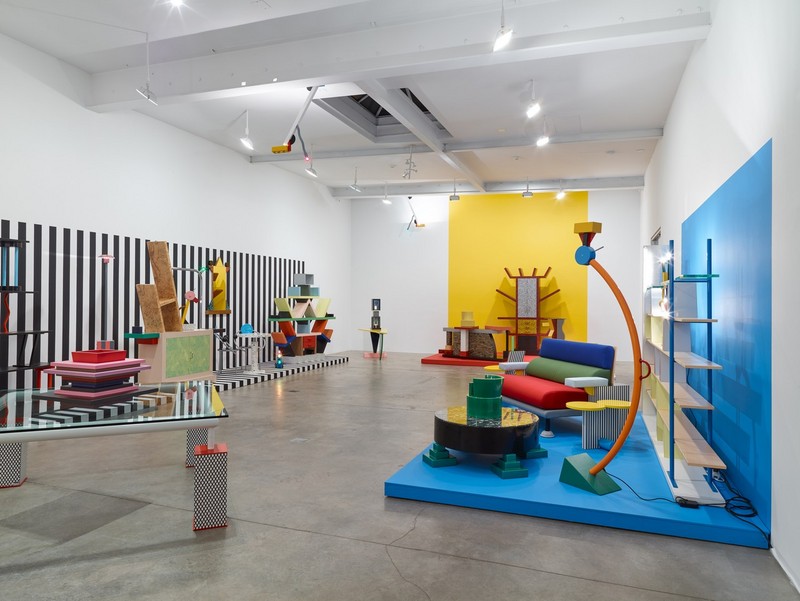The Memphis Group
18 Dec 2014 - 31 Jan 2015
THE MEMPHIS GROUP
18 December 2014 – 31 January 2015
“It is no coincidence that the people who work for Memphis don’t pursue a metaphysic aesthetic idea or an absolute of any kind, much less eternity. Today everything one does is consumed. [Memphis] is dedicated to life, not to eternity.”
–Ettore Sottsass
Koenig & Clinton is pleased to announce The Memphis Group, an exhibition of furniture and lighting by the 1980s Postmodern design collective. The partner exhibition of The Memphis Group, collaboratively produced by Joe Sheftel and Rudy Weissenberg, is on view at Joe Sheftel Gallery through January 11, 2015.
Following its debut at the Milan Furniture Fair in 1981, the Memphis group grew to include numerous artists, designers, and architects. The gallery’s presentation spotlights a small sliver of Memphis’ numerous associates: Martine Bedin, Andrea Branzi, Aldo Cibic, Michele De Lucchi, Shiro Kuramata, Peter Shire, Ettore Sottsass, and George Sowden. These individuals were part of a larger group that also included founding members Marco Zanini, Matteo Thun, and Nathalie Du Pasquier. The emblematic furniture and lighting designs on view demonstrate the collective’s greater ethos of irreverence, a challenge to Modernist tenets of good taste and efficacy.
Pillars of Memphis design include unconventional combinations of materials—such as slabs of marble alongside fiberglass and laminates—and historic forms embellished with kitsch patterns and gaudy colors. Joyful, witty, and rebellious, Memphis forms do not follow function. Instead, Memphis infiltrates the traditionally feminine domestic space with stubborn architectural structures that playfully overturn the roles of comfort and practicality in interior design. And while Memphis is often classified as Postmodern because of its provocative blending of historic styles, it was also international in origin and reach.
Memphis evolved out of Studio Alchimia, a band of architect-designers who forged “Il Nuovo Design”, an alternative to high-end Italian décor in the late-1970s. Studio Alchimia reacted to mass production with objects that fused arts-and-crafts workmanship with Populuxe aesthetics, and rejected the notion that interior design should submit to conventional modes of marketability and visual hierarchy. In departure from Alchimia, Memphis made full use of mass production techniques.
Three decades on, Memphis continues to influence the visual language of designers and artists working today, and has once again been embraced by mainstream culture. While for one generation it may remain associated with a high Postmodernism that equated stylistic eclecticism with ‘the end of history’, Memphis now enjoys a revival in the digital age. Galvanized by post-Internet design, Memphis is celebrated for its definitively sculptural, three-dimensional, grafted character and offers a refreshing reprieve from the flat, one-dimensional visual space of screens.
18 December 2014 – 31 January 2015
“It is no coincidence that the people who work for Memphis don’t pursue a metaphysic aesthetic idea or an absolute of any kind, much less eternity. Today everything one does is consumed. [Memphis] is dedicated to life, not to eternity.”
–Ettore Sottsass
Koenig & Clinton is pleased to announce The Memphis Group, an exhibition of furniture and lighting by the 1980s Postmodern design collective. The partner exhibition of The Memphis Group, collaboratively produced by Joe Sheftel and Rudy Weissenberg, is on view at Joe Sheftel Gallery through January 11, 2015.
Following its debut at the Milan Furniture Fair in 1981, the Memphis group grew to include numerous artists, designers, and architects. The gallery’s presentation spotlights a small sliver of Memphis’ numerous associates: Martine Bedin, Andrea Branzi, Aldo Cibic, Michele De Lucchi, Shiro Kuramata, Peter Shire, Ettore Sottsass, and George Sowden. These individuals were part of a larger group that also included founding members Marco Zanini, Matteo Thun, and Nathalie Du Pasquier. The emblematic furniture and lighting designs on view demonstrate the collective’s greater ethos of irreverence, a challenge to Modernist tenets of good taste and efficacy.
Pillars of Memphis design include unconventional combinations of materials—such as slabs of marble alongside fiberglass and laminates—and historic forms embellished with kitsch patterns and gaudy colors. Joyful, witty, and rebellious, Memphis forms do not follow function. Instead, Memphis infiltrates the traditionally feminine domestic space with stubborn architectural structures that playfully overturn the roles of comfort and practicality in interior design. And while Memphis is often classified as Postmodern because of its provocative blending of historic styles, it was also international in origin and reach.
Memphis evolved out of Studio Alchimia, a band of architect-designers who forged “Il Nuovo Design”, an alternative to high-end Italian décor in the late-1970s. Studio Alchimia reacted to mass production with objects that fused arts-and-crafts workmanship with Populuxe aesthetics, and rejected the notion that interior design should submit to conventional modes of marketability and visual hierarchy. In departure from Alchimia, Memphis made full use of mass production techniques.
Three decades on, Memphis continues to influence the visual language of designers and artists working today, and has once again been embraced by mainstream culture. While for one generation it may remain associated with a high Postmodernism that equated stylistic eclecticism with ‘the end of history’, Memphis now enjoys a revival in the digital age. Galvanized by post-Internet design, Memphis is celebrated for its definitively sculptural, three-dimensional, grafted character and offers a refreshing reprieve from the flat, one-dimensional visual space of screens.

